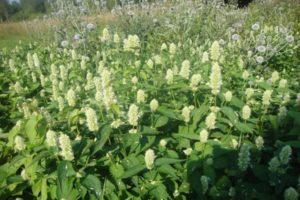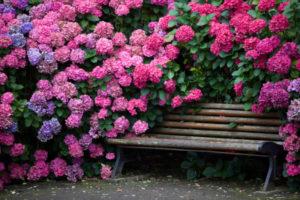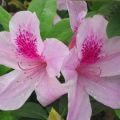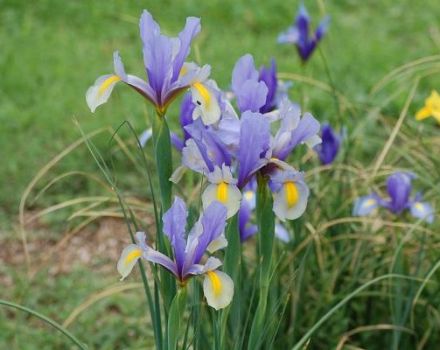Rules for planting and caring for perennial daisies, description of varieties and species
Among the variety of flower crops, garden daisies occupy a leading position. These flowers deserve special attention - they adorn any flower beds, bloom for a long time, do not impose increased requirements. For planting perennial daisies, as a rule, the most noticeable places are chosen; caring for such flower beds does not require much effort.
Description and features
Daisies belong to the Astro family. About 80 varieties of the flower have been bred by selection. This culture began its existence in the fields of Europe, was gradually domesticated and firmly took its place among the most popular garden flowers.
Description:
- roots: short, spatulate;
- leaves: bright, tightly adjacent to each other;
- inflorescences: of various types, with a slight rise of the flower above the leaf rosette;
- flowers: petals can be from 1 to 5 or more rows.
Growing
To breed a daisy, use one of the available methods. On the territory of the southern regions, seeds are sown in open ground, in temperate or moderate continental climates, prepared seedlings are planted.
Seedling method
Many flower growers plant prepared seedlings in open ground areas. This allows for faster flowering.

Timing
The optimal time for sowing is considered the end of February-beginning of March. The time from sowing to planting in a permanent place of growth will be sufficient to obtain strong seedlings with the necessary amount of true leaves.
How to plant
Daisy seeds are preferred to be sown in separate containers. This method eliminates damage to the root system when diving and increases the ability of seedlings.
Soil requirements
In order for the seeds to sprout and the seedlings begin to grow, a soil is prepared that takes into account the characteristics of the culture:
- the soil should be light and loose, let air and moisture pass freely;
- contain nutrients: potassium, phosphorus, magnesium;
- be disinfected in advance.
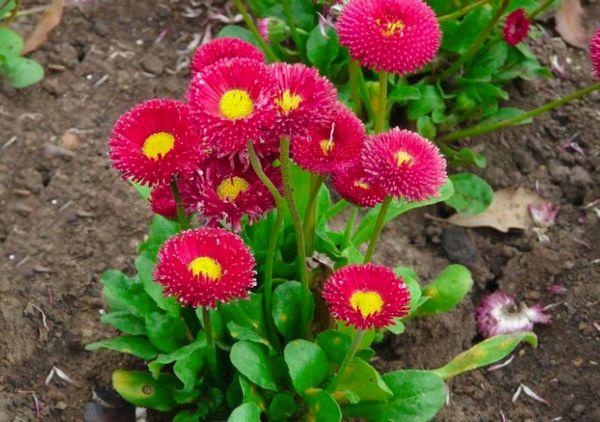
Temperature regime
Before the sprouts appear, the planting is left at a temperature of +20 to +25 degrees.After the emergence of seedlings, containers with seedlings are removed to where the air temperature is kept at the border from +16 to +20 degrees.
Lighting
For seedlings to appear faster, they need at least 12 hours of daylight. Lack of lighting can lead to wilting of the leaves.
Landing in open ground
When sowing seeds, take into account that the planting of seedlings in a permanent place of growth should be at the beginning of summer. In the wells prepared in advance, one seedling is transplanted by the transfer method. It helps keep the root system intact.
Advice! A distance of 20 centimeters is left between the seedlings.
Seedless sowing method
This method is suitable for regions where spring begins earlier, and does not present surprises in the form of return frosts. The seeds are prepared in advance: they are checked for germination, soaked or calcined.
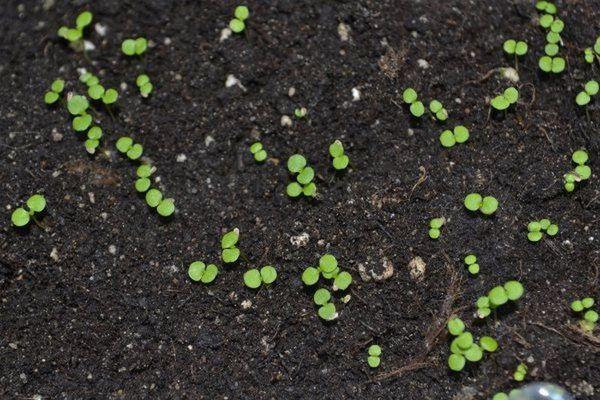
Timing
Seeds begin to be planted on open ground, provided that the soil is warmed up to +15 degrees. Despite the adaptive qualities of daisies, the planting material can freeze in too cold soil.
Site and soil selection
Daisies are planted in areas where they can get enough sun. But the scorching rays of the sun can harm them, so the choice can be stopped in shaded areas.
The soil for daisies should be fertilized in the fall and have an approximate acidity level of about 6 ph. The best option would be if the groundwater at the site runs as low as possible.
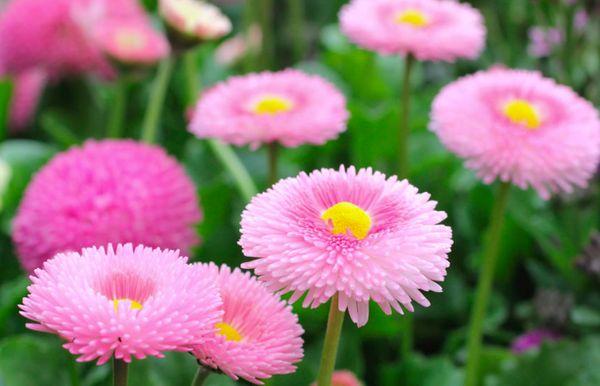
Warning! Places where moisture stagnates are not suitable for daisies. Damp soil can damage the root system.
Landing scheme
Daisies are sown in rows. The scheme depends entirely on the characteristics of the site. The holes are deepened by no more than 2.5 centimeters, between the bushes they leave from 20 to 25 centimeters.
Picking
When planting, many gardeners bury 2-3 seeds in the holes, so seedlings may be too frequent. If there are 2 or 3 strong shoots, they are dug out and seated according to the adopted scheme.
Thinning
Planting daisies too often can be another problem at this stage. So that they do not interfere with each other's growth, they choose the strongest shoot, and remove the weak and unviable one.
How to care
Crop care includes the usual set of agricultural techniques. Daisies are called unpretentious flowers, so they do not require special attention.
Watering
The fragile root system of the flower does not tolerate waterlogging. Staying in damp ground leads to shrinking of inflorescences and contributes to the development of fungal diseases. Garden daisies are watered as the topsoil dries.
Weeding and loosening
These are the must-haves for looking after. After watering, the ground around the bushes is weeded and loosened to provide additional air access.
Mulching
To exclude the possibility of the development of fungal diseases, to prevent the formation of weeds and the invasion of insects - pests, many gardeners mulch the ground around the flower for the whole summer. To do this, use freshly cut grass, sawdust or needles.

Top dressing
During flowering, daisies are fed with potash-phosphorus mixtures for flower crops. After planting or transplanting to areas of open ground, daisies are not fed for 2-3 weeks, so as not to disrupt the natural adaptation process.
Pruning inflorescences
Daisies are able to bloom profusely all summer. To make this process more active, the faded parts are cut off. In this case, gardeners recommend not to wait for the complete withering away of the inflorescence, but to pinch it off at an early stage of flowering.
Transfer
In the fall, the plant is transplanted for 2 years of existence. The transplant scheme is left the same.
Reproduction
To breed daisies, choose one of the methods.When daisy bushes grow, breeding by dividing is suitable.
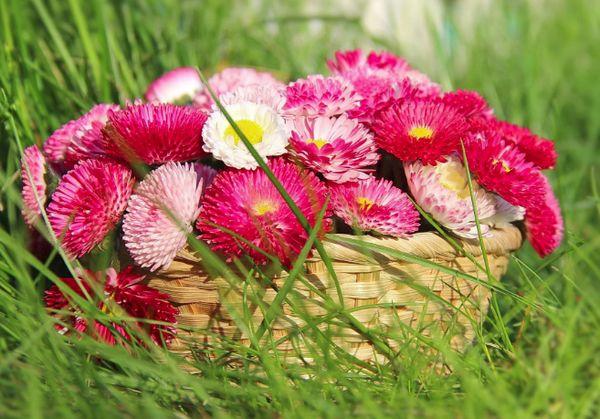
Generative
This is the main method of planting seeds. It is usually used in cases where there are no adult daisies on the sites. Seedlings are grown by seed for the main plantings.
Vegetative
These methods are used to breed flowers already growing on the site. Cuttings are more suitable for breeding a plant, part of which is sick or dies off due to pests.
Cuttings
The stalk is pinched off from an adult plant in the fall, then rooted at home during the winter and spring. The rooted stalk is planted and grown like seedlings. In the spring, the daisy is transferred to open ground.

Dividing the bush
In spring or autumn, a strong mother plant is chosen, dug out of the ground, divided into 2 parts with a sharp garden knife. Then the roots are treated with a growth stimulant and both parts are planted as independent bushes.
Diseases and pests
The daisy is prone to disease due to the fragility of the root system. She also cannot resist pest infestations without additional help.
Powdery mildew
The fungus attacks the roots if the plant is transfused. Powdery mildew can develop due to prolonged rains. To cure a flower, it is sprayed with a manganese solution.
Mite
The parasite spreads to daisies from neighboring crops. It eats stems and leaves, weakens the plant. To remove the tick, the bushes are sprayed with a soapy or tobacco solution.

Mouse
Rodents often harm daisies. They appear in the fall and can destroy the root system. In areas where rodents are common, traps or chemicals are placed to get rid of them.
Bronze of leaves
The virus is spread by insects. The leaf plates are stained. Sick daisies are sprayed with fungicides.
Brown spot
Spots cover the entire plant. The disease develops due to waterlogging of the soil. At an early stage of the disease, the flower is dug up, dried and transplanted.
Gray rot
A gray coating appears due to dampness. After the cessation of watering, the bushes are treated with fungicides.

Rust
The soil fungus attacks the roots, then rusty spots appear on the leaves. If the treatment does not help, then the affected part of the plantings is dug up, destroyed. The contaminated soil is disinfected.
After flowering
When the daisies have faded, seed harvesting begins. The next step is preparation for winter.
Collection and storage of seeds
Seeds ripen unevenly in daisies. The collection is stretched over a long period. The faded inflorescences are shaken, the resulting seeds are dried and stored in the dark and dry.
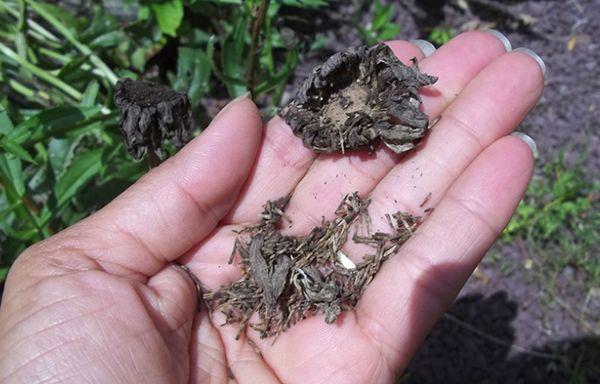
Preparing for winter
Daisies are able to hibernate in areas of soil. In order for the bushes not to freeze, the preparation is divided into several stages:
- mulch the soil layer with humus;
- cover the bushes with spruce branches, sawdust or agrofibre.
To prepare the daisies for winter, they are pruned, leaving 2-3 centimeters above the ground.
Kinds
Among the variety of varieties, the main types are distinguished. Annual daisies are planted for 1 season, perennials endure wintering and bloom profusely for several years in a row.
Annuals
Varieties of annual daisies are used to decorate balconies and terraces. In flower beds, they are able to bloom until the first frost.
Perennial
The flowering of perennials lasts throughout the summer; it can persist until the onset of cold weather. Seeds of perennial flowers ripen in late summer and early autumn.
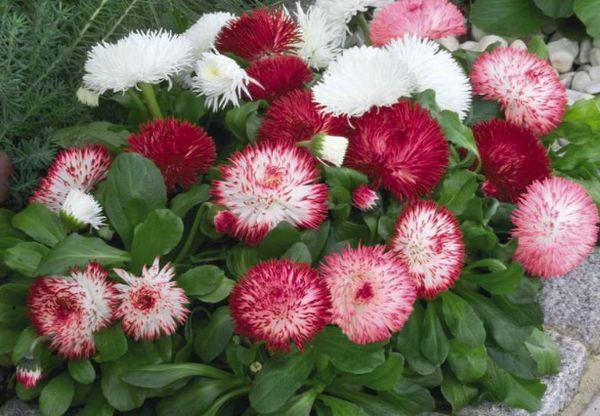
Simple inflorescences
These varieties bloom the longest. Flowers are collected in simple inflorescences. The shade of the petals depends on the variety.
Semi-double
These are varieties that have a special structure. The central yellow disc is surrounded by 4 or more rows of petals of different shades.
Terry
This is the most attractive variety of daisies. There are so many petals on the flower that you cannot see the central circle behind them. In their shape, they resemble a terry ball, this explains their name.
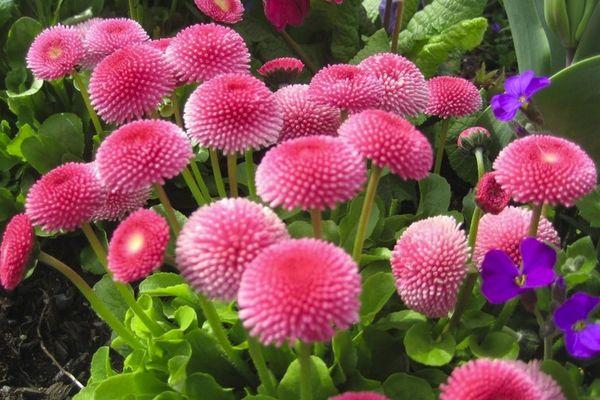
Popular varieties
Among the variety of hybrid varieties, gardeners distinguish several dozen. The varieties are loved and recognized by collectors.
Robella
The flower grows up to 15 centimeters. Tubular inflorescences form rows of creamy pink petals.
Rob Roy
The height of the bush reaches 10 centimeters. The petals are bright red.
Bella Daisy
Red or pink flowers of the variety reach 2.5 centimeters in diameter. The petals brighten towards the tips.

Pomponette
A small bush is crowned with a flower that looks like a pompom. The shade of the petals can be different.
Tasso
Inflorescences of the tubular type form pom-pom flowers of bright colors. The bush grows up to 10 centimeters.
Speedstar
The flower is a classic type with a yellow center. The petals are wide, lanceolate.
Rominette
Terry variety with small flowers. Usually purple or purple-red.

Aucubaefolia
Flowers of this variety are collected in reed inflorescences. The bush grows up to 15 centimeters.
Shrewley gold
The white petals have pink-colored tips. The stems of this variety are thin and fragile.
Prolifera
Terry variety of lilac or burgundy hue. Flowering begins in early spring and ends in late autumn.
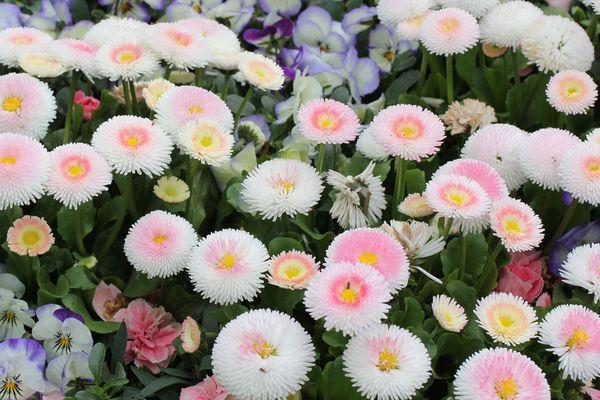
Schneebel
The flowers of this variety are snow-white. Up to 20 inflorescences can form on a bush.
Rose of Gigantea
A variety with large flowers. The shade of the petals is from red to burgundy.
Beethoven
Semi-double grade. The height of the bush is 15-20 centimeters.
Dresden Chyna
Early daisies. Flowers reach 3 centimeters in diameter.
The Pearl
A small flower of semi-double type. The color of the petals is pearly white.
Use in landscape design
Landscape designers love to use daisies to create layered compositions. Daisies liven up any area with their varied shades.
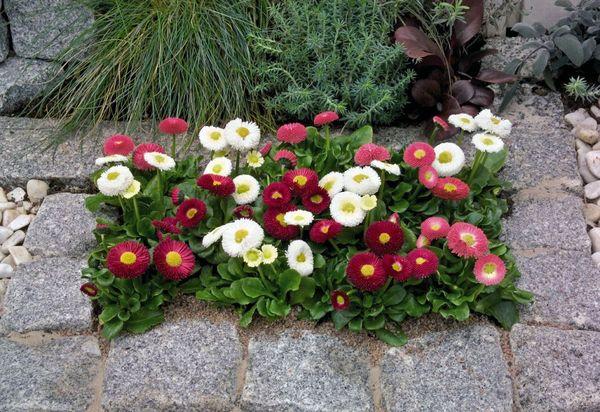
How to grow at home
The daisy can be grown as a houseplant. Flowering coincides with the flowering period of perennial species. In the second year of existence, the flowers begin to shrink. At home, daisies are bred by seed, as well as by cuttings.
